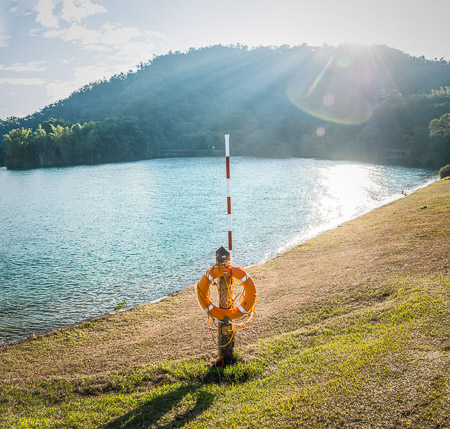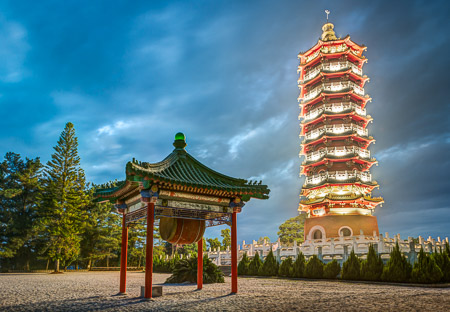Sun Moon Lake in Taiwan

The beauty of Sun Moon Lake is well known in China, and also in Japan, which ruled Taiwan from 1895 to 1945. Engineers working for the colonial government cut channels and tunnels to divert water that would otherwise have drained into the Taiwan Strait via the Zhuoshui River; at 186 km (116 miles) in length, it is Taiwan’s longest waterway. By 1934, the lake had almost doubled in area to its current size of almost 8 km2, while its average depth had quadrupled to 27 m (89 ft).
Many tourists alight from buses in Shuishe, a mini-town with several hotels. Of those who don’t get on a hired bicycle, a good number begin their sightseeing with a stroll along the Hanbi Peninsula. The church where Chiang Kai-shek worshipped whenever he was in the area still stands but his personal retreat was levelled years ago. Moving clockwise around the lake, the next stop is Wenwu Temple. In addition to being perfectly located for splendid views over the water, it’s unusual in being dedicated to both the scholar Confucius (China’s most revered philosopher) and the soldier Guan Gong (a great general now worshipped as the god of businesspeople, policemen, and others).
Tea, tribes, and temples
Located just north of the lake, Antique Assam Tea Farm preserves and explains traditional organic tea-growing and preparation methods. This is the only place in Taiwan where Assam tea is grown; elsewhere, oolongs predominate.
For many visitors, their favourite memories of this region feature the Sun Moon Lake Ropeway, an intensely scenic cable-car ride from the lakeshore, over the forest and into Formosan Aboriginal Culture Village. The ropeway is 1.87 km (1.16 miles) long and a one-way trip takes ten minutes; the family-friendly village presents the music, dances, attire and traditional construction methods of Taiwan’s indigenous people. It’s also a theme park with some thrilling rides!
Just a short walk from the ropeway terminal and populated by a mix of Thao Austronesians and Taiwanese of Han Chinese descent, Ita Thao is the second-largest lakeside community and an excellent place to stop for lunch.

Near the lake’s southern shore, Xuanzang Temple and Xuanguang Temple hold relics associated with Xuanzang, a 7th-century Chinese monk revered by Buddhists throughout East Asia for making a perilous 16-year pilgrimage across the Himalaya to India, where he gathered and translated religious texts. Chiang Kai-shek loved Sun Moon Lake as much as anyone, and to commemorate his mother he commissioned the building of Cien Pagoda. The panoramic views over and beyond the lake make climbing the stairs to the upper floors well worth the effort. The structure’s height, 46 m (151 ft), was chosen so the top would be precisely 1,000 m (3,281 ft) above sea level.
The calm waters of Sun Moon Lake cry out to be enjoyed from a leisure craft, and customised boat tours are both popular and relatively inexpensive.
In addition to the short trails and boardwalks close to the water’s edge, the hills which encircle Sun Moon Lake offer some strenuous hiking opportunities. Tramping through forests is best done in the cooler months, but this region has a particular appeal in every season. In summer, visitors to the lake enjoy temperatures far milder than those in Taiwan’s major cities, the mercury seldom topping 28 degrees Celsius (82 degrees Fahrenheit). Between November and February, daytime temperatures seldom sink below 10 degrees Celsius (50 degrees Fahrenheit), while many afternoons see a delightfully comfortable 20 degrees Celsius (68 degrees Fahrenheit). Four to five hours of sunshine per day is typical year-round.
